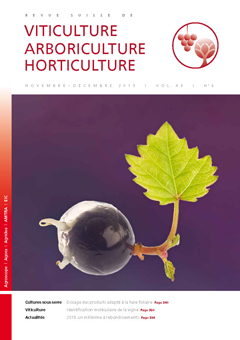
Issue 6 - November - December 2013
Abstract in open access
Various methods for the harmonization of the registration of crop protection products and dose adjustments in high growing crops have been discussed over many years. The leaf wall area (LWA) method has been known for some years already but received renewed attention due to a proposal by the European agrochemical manufacturing industry for harmonizing the dose expression in view of the new zonal registration system in the EU. The LWA method appears not only suitable for fruit trees and vineyards, but may also prove a simple and widely accepted method for dose adjustments in high growing vegetable crops particularly in greenhouses. This paper provides a dataset on the development of the leaf wall area and the leaf area for cucumber, eggplant, sweet pepper and tomato varieties grown in Switzerland. Relationships between the leaf wall area and the leaf area have been established. A tentative product dose adjustment to growing vegetable crops in greenhouses is given for Switzerland. Biological efficacy trials will be required to validate the LWA method.
Keywords: pesticides, greenhouse, horticulture, application technique, leaf wall area, leaf area, tomato, cucumber, eggplant, sweet pepper
E-Mail: mauro.jermini@agroscope.admin.ch
Adress: Agroscope, 6593 Cadenazzo
Abstract in open access
Authenticating accessions from an in vitro collection established for long term conservation has become a priority for numerous research laboratories. At Agroscope, the genotypic profiles of the grapevine accessions have been established using 38 microsatellites. The analysis of the results and comparison with those of a Swiss database and of an European database allowed to confirm the identity of the grape cultivars in the collection. 41 accessions representing 20 cultivars have thus been authenticated. The genotypic process also allowed to verify the results of crosses issued from the grapevine breeding programme of Agroscope by parentage analysis. Profiles from 8 recent cultivars were compared with those of their progenitors among others and thus confirmed their identity.
Keywords: microsatellite, SSR, molecular identification, parentage, grapevine
E-Mail: eric.droz@agroscope.admin.ch
Adress: Agroscope, 1260 Changins/Nyon
Abstract in open access
The old vineyards of a renowned castle in the Medoc wine region have been top grafted by chip-budding method from 2008 to 2012. The results obtained during the first three years upon thirty years-old vine stocks (80.5 % success rate) led to the top graft of sixty years-old vine stocks during the following two years. The success rate was then 76.1 %. This article presents the conditions of implementation, the description and the stand factors of this method.
Keywords: top grafting, chipbudding, old vineyard, old vine stock, wine grape
E-Mail: lepibiote@orange.fr
Adress: Company L'Epibiote, Pézenas (F)
Abstract in open access
This study aimed to develop on the 2011 vintage sensory methods for the characterisation of Chenin variety berries. The different potential qualities of Chenin grapes were classified in three types of white wines: Crémant (base wine), fresh white wine called «Printemps» and «Vin de caractère». For this purpose, a panel of eleven trained tasters characterised grapes from 17 different harvests, each of which was intended to elaborate one of these three types of Chenin wines. Twenty-seven descriptors of aromas, flavours, texture and appearance were evaluated and scored from zero to ten based on their intensity by the trained panel. This work will provide rigorous and rapid sensory methods for characterising Chenin grapes, able to fit the needs of professionals wishing an accurate characterisation of their products in a limited time.
Keywords: sensory methods, grape, Chenin, quality, potential, type of wine
E-Mail: r.siret@groupe-esa.com
Adress: Ecole supérieure d'agriculture d'Angers ESA, F-49007 Angers Cedex 01

 Download of full issue
Download of full issue
 Download article
Download article